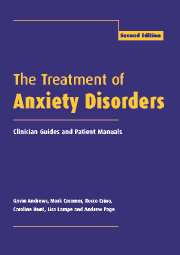Book contents
- Frontmatter
- Contents
- List of authors
- Preface to the second edition
- Abbreviations
- 1 Read me
- 2 General issues in anxiety disorders
- 3 General issues in treatment: Clinician Guide
- 4 Panic disorder and agoraphobia: Syndrome
- 5 Panic disorder and agoraphobia: Treatment
- 6 Panic disorder and agoraphobia: Clinician Guide
- 7 Panic disorder and agoraphobia: Patient Treatment Manual
- 8 Social phobia: Syndrome
- 9 Social phobia: Treatment
- 10 Social phobia: Clinician Guide
- 11 Social phobia: Patient Treatment Manual
- 12 Specific phobias: Syndrome
- 13 Specific phobias: Treatment
- 14 Specific phobias: Clinician Guide
- 15 Specific phobias: Patient Treatment Manual
- 16 Obsessive-compulsive disorder: Syndrome
- 17 Obsessive-compulsive disorder: Treatment
- 18 Obsessive-compulsive disorder: Clinician Guide
- 19 Obsessive-compulsive disorder: Patient Treatment Manual
- 20 Generalized anxiety disorder: Syndrome
- 21 Generalized anxiety disorder: Treatment
- 22 Generalized anxiety disorder: Clinician Guide
- 23 Generalized anxiety disorder: Patient Treatment Manual
- 24 Posttraumatic stress disorder: Syndrome
- 25 Posttraumatic stress disorder: Treatment
- 26 Posttraumatic stress disorder: Clinician Guide
- 27 Posttraumatic stress disorder: Patient Treatment Manual
- 28 Conclusions
- References
- Index
17 - Obsessive-compulsive disorder: Treatment
Published online by Cambridge University Press: 05 August 2016
- Frontmatter
- Contents
- List of authors
- Preface to the second edition
- Abbreviations
- 1 Read me
- 2 General issues in anxiety disorders
- 3 General issues in treatment: Clinician Guide
- 4 Panic disorder and agoraphobia: Syndrome
- 5 Panic disorder and agoraphobia: Treatment
- 6 Panic disorder and agoraphobia: Clinician Guide
- 7 Panic disorder and agoraphobia: Patient Treatment Manual
- 8 Social phobia: Syndrome
- 9 Social phobia: Treatment
- 10 Social phobia: Clinician Guide
- 11 Social phobia: Patient Treatment Manual
- 12 Specific phobias: Syndrome
- 13 Specific phobias: Treatment
- 14 Specific phobias: Clinician Guide
- 15 Specific phobias: Patient Treatment Manual
- 16 Obsessive-compulsive disorder: Syndrome
- 17 Obsessive-compulsive disorder: Treatment
- 18 Obsessive-compulsive disorder: Clinician Guide
- 19 Obsessive-compulsive disorder: Patient Treatment Manual
- 20 Generalized anxiety disorder: Syndrome
- 21 Generalized anxiety disorder: Treatment
- 22 Generalized anxiety disorder: Clinician Guide
- 23 Generalized anxiety disorder: Patient Treatment Manual
- 24 Posttraumatic stress disorder: Syndrome
- 25 Posttraumatic stress disorder: Treatment
- 26 Posttraumatic stress disorder: Clinician Guide
- 27 Posttraumatic stress disorder: Patient Treatment Manual
- 28 Conclusions
- References
- Index
Summary
Although OCD has been recognized for centuries, effective treatment for this condition has been available only for the past four decades. The treatments of choice for OCD are behavior therapy, consisting of exposure and response prevention, and selective serotonin reuptake-inhibiting medications. Recent studies have also included specific cognitive techniques targeting the appraisals of intrusive thoughts, responsibility for harm and threat estimates. fihether the addition of such techniques results in superior efficacy is yet to be demonstrated in further trials. Nevertheless, the use of cognitive techniques to challenge the dysfunctional appraisal of intrusive thoughts is warranted in individuals with cognitive styles that interfere with treatment. Cure of OCD is not commonplace. The primary goal of treatment in the majority of cases is to have the individual control the disorder rather than the obsessional disorder control the individual. Achievement of this goal allows the patient to minimize the impact and effects of the disorder on their daily life and enhances their ability to reach their full potential.
Behavioral therapy
The basic principles of exposure and response prevention include the deliberate exposure to obsessional cues and prevention of the behaviors that the sufferer typically engages in to lessen the anxiety, discomfort, or distress associated with the feared stimuli. Repeatedly employing prolonged exposure (45 minutes to 2 hours) to the obsessional cues, with strict response prevention, allows habituation to take place. Exposure tasks are arranged hierarchically, with treatment commencing with the least anxiety-provoking situation and progressing rapidly through the hierarchy.
In reviewing the results of more than 200 OCD patients treated with behavior therapy in several countries, Foa et al. (1985) reported that 51% of sufferers achieved at least a 70% reduction in symptoms. Thirty-nine percent of patients 347 Obsessive–compulsive disorder: Treatment achieved reductions ranging from 31% to 69%, and 10% were considered failures, failure being defined as patients with an improvement of 30% or less. At follow-up (mean duration 1 year), the number of failures increased from 10% to 24%. However, 76% of patients remained improved to a degree rated as moderately improved or better.
Further evidence for the efficacy of exposure and response prevention is reflected in a long-term follow-up of nine cohorts from five countries conducted by O'Sullivan et al. (1991). Both self- and assessor ratings were used, and two cohorts had received exposure plus either clomipramine or placebo.
- Type
- Chapter
- Information
- The Treatment of Anxiety DisordersClinician Guides and Patient Manuals, pp. 346 - 353Publisher: Cambridge University PressPrint publication year: 2002



